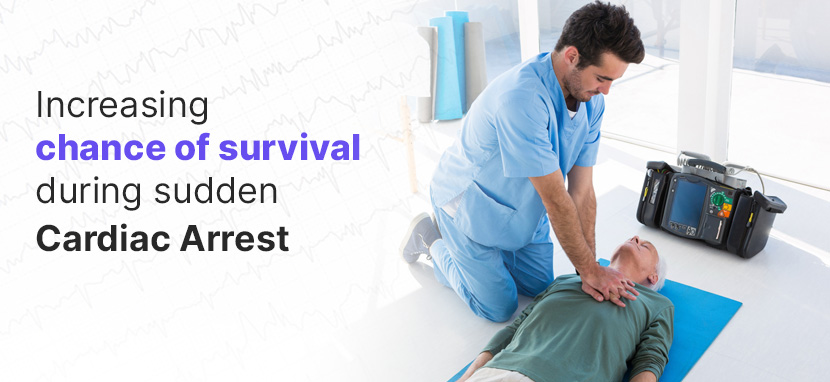
Increasing Chances of Survival During Sudden Cardiac Arrest
What is Sudden Cardiac Arrest?
Sudden Cardiac Arrest is a condition during which the heart suddenly losses all of its activity due to an irregular heart rhythm. When this happens, the heart stops beating completely, due to which blood stops flowing to the brain and other vital organs. In the event of a Sudden Cardiac Arrest, the victim becomes unconscious. If immediate treatment is not provided, sudden cardiac arrest can lead to death.
How to save lives in the event of an out-of-hospital Sudden Cardiac Arrest?
In the event of an out-of-hospital Sudden Cardiac Arrest (SCA), Emergency Cardiovascular Care (ECC) is the most important life-saving procedure that needs to be provided to patients. The ECC procedure comprises of a series of actions that need to be performed in rapid succession to maximize the chances of survival of a Sudden Cardiac Arrest patient1. This series of six actions is called as “Chain of Survival”. They are:
- Recognize SCA and Call EMS: Check pulse and breathing. If absent, call emergency medical services for help1.
- CPR: Start cardiopulmonary resuscitation (CPR)1.
- Rapid defibrillation: Provide using Automated External Defibrillator (AED)1.
- Advanced resuscitation: Emergency Medical Services arrive, provide advanced life support and transport patient to hospital1.
- Post -cardiac arrest care: Provided by the hospital.
- Recovery: Includes additional treatment, observation, rehabilitation, and psychological support by the Caregiver Team.
Providing cardio pulmonary resuscitation and rapid defibrillation are recognized as two significant actions in the ‘Chain of Survival’ for saving the life of the patient, in the event of a Sudden Cardiac Arrest. According to the American Heart Association, immediate CPR can double or triple chances of survival of the patient, after SCA2.
Cultivate a culture of proactive heartcare to save yourself from Heart Attack and Sudden Cardiac Arrest. Respond immediately to cardiac emergencies.
What is cardiopulmonary resuscitation (CPR)?
Cardiopulmonary resuscitation (CPR) is an emergency procedure performed to manually assist a person who is experiencing cardiac arrest or is not breathing. CPR involves a combination of chest compressions and rescue breaths to maintain blood circulation and oxygenation until further medical assistance arrives1.
Why cardiopulmonary resuscitation increases chances of survival?
When the heart stops beating, cardiopulmonary resuscitation helps keep blood flowing to the brain and other vital organs until help arrives. The chest compressions manually pumps blood through the body, helping to maintain circulation even when the heart is not beating effectively. This circulation ensures that vital organs, particularly the brain, receive oxygenated blood, reducing the risk of irreversible damage2. Cardiopulmonary resuscitation is a critical intervention that can significantly improve the chances of survival for individuals in cardiac arrest1.
What is an Automated External Defibrillator (AED)?
An Automated External Defibrillator restarts the heart by analyzing and re-establishing heart rhythm. These portable devices are designed to be user-friendly, enabling both medical professionals and laypeople to administer life-saving treatment to individuals experiencing sudden cardiac arrest1.
Significance of Automated External Defibrillators in increasing chances of survival?
Automated External Defibrillators play a pivotal role in the chain of survival for individuals experiencing sudden cardiac arrest. These devices are equipped with sophisticated technology that allows them to analyze the heart's rhythm and deliver a controlled electric shock if necessary. The shock is intended to reset the heart's electrical activity, potentially restoring a normal heartbeat. Importantly, AEDs are programmed to only administer a shock when specific irregular heart rhythms, such as ventricular fibrillation or ventricular tachycardia, are detected. This feature ensures that the treatment is targeted and appropriate.
An Automated External Defibrillator restarts the heart by analyzing and re-establishing heart rhythm. These portable devices are designed to be user-friendly, enabling both medical professionals and laypeople to administer life-saving treatment to individuals experiencing sudden cardiac arrest.
User-Friendly Design of Automated External Defibrillators?
Automated External Defibrillators play a pivotal role in the chain of survival for individuals experiencing sudden cardiac arrest. These devices are equipped with sophisticated technology that allows them to analyze the heart's rhythm and deliver a controlled electric shock if necessary. The shock is intended to reset the heart's electrical activity, potentially restoring a normal heartbeat. Importantly, AEDs are programmed to only administer a shock when specific irregular heart rhythms, such as ventricular fibrillation or ventricular tachycardia, are detected. This feature ensures that the treatment is targeted and appropriate.
One of the most remarkable aspects of AEDs is their user-friendly design. These devices are engineered to be intuitive and accessible, even for individuals without medical training. They typically feature clear visual and audio prompts that guide users through each step of the resuscitation process. From placing the adhesive pads on the patient's chest to delivering the shock, AEDs provide step-by-step instructions to ensure proper execution.
Role of Automated External Defibrillators in Empowering Communities?
The presence of Automated External Defibrillators in various locations empowers communities to respond effectively to sudden cardiac arrest incidents. In many cases, rescuers trained in CPR and AED use have been instrumental in saving lives. By equipping individuals with the knowledge and tools to intervene during SCA incidents, AEDs contribute to a culture of preparedness and effective emergency response.
Automated External Defibrillators (AEDs) represent a significant advancement in emergency medical care, offering a lifeline to individuals experiencing sudden cardiac arrest. In India, AEDs need to be integrated into public spaces and workplaces to improve outcomes for out-of-hospital sudden cardiac arrests and save lives. Investing in AEDs and promoting education on their use are essential steps toward creating safer and more resilient communities.
1.Cardiac Arrest by Kevin Patel, Western Michigan University and John E. Hipskind, Kaweah. https://www.ncbi.nlm.nih.gov/books/NBK534866/
2.Cardiac Arrest: Resuscitation and Reperfusion by Kaustubha D. Patil, Department of Medicine, Division of Cardiology, Johns Hopkins University, Baltimore, MD (K.D.P., H.R.H.); Henry R. Halperin, Department of Medicine, Division of Cardiology, Johns Hopkins University, Baltimore, MD (K.D.P., H.R.H.); Lance B. Becker, Department of Medicine, Division of Cardiology, Johns Hopkins University, Baltimore, MD (K.D.P., H.R.H.)
https://www.ahajournals.org/doi/10.1161/CIRCRESAHA.116.304495
